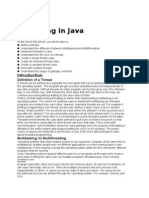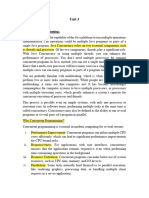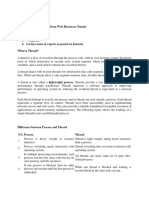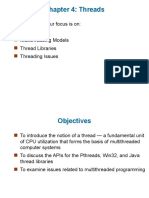0 ratings0% found this document useful (0 votes)
4 viewsMultiple Threads
Uploaded by
danielbirhanu0374Copyright
© © All Rights Reserved
Available Formats
Download as PPTX, PDF, TXT or read online on Scribd
0 ratings0% found this document useful (0 votes)
4 viewsMultiple Threads
Uploaded by
danielbirhanu0374Copyright
© © All Rights Reserved
Available Formats
Download as PPTX, PDF, TXT or read online on Scribd
You are on page 1/ 11
Multiple Threads
What is Multiple Threads?
Why Use Multiple Threads?
How to Thread Creation in Java
Thread Life Cycle
Advantages of Multiple Threads
Challenges of Multiple Threads
What is Multiple Threads?
Is refer to the concurrent execution of two or
more threads in a program.
A thread is the smallest unit of a CPU's execution
A program can have multiple threads running at
the same time
Is a technique in which multiple threads are used
to perform different tasks in parallel within a
single program.
Why Use Multiple Threads
Improved Performance and Responsiveness:-
By using multiple threads, programs can perform multiple
operations concurrently, which improves efficiency and
responsiveness.
Efficient CPU Utilization:- multiple threads can run
simultaneously on different cores. This leads to better CPU
utilization
Concurrency in Applications:-Multithreading is
useful in applications that need to handle several tasks at
once,
Thread Creation in Java
1) Using the Thread Class:-In Java, a thread can be
created by subclassing the Thread class and overriding its run()
method.
example:
class MyThread extends Thread {
public void run() {
System.out.println("Thread is running");
}
}
MyThread t = new MyThread();
t.start();
2) Using the Runnable Interface:- This allows the class
to implement the run() method, and then pass an instance of the
class to a Thread object.
Example:
class MyRunnable implements Runnable {
public void run() {
System.out.println("Thread is running");
}
}
MyRunnable r = new MyRunnable();
Thread t = new Thread(r);
t.start();
Thread Life Cycle
New:- Thread object created.
Runnable:- Ready to run but waiting for CPU.
Running:-Actively executing.
Blocked/Waiting:- Waiting for a resource.
Terminated:- Completed execution.
Advantages of Multiple Threads
Improved Program Performance:- programs can be
executed more efficiently, especially on multi-core processors.
Better Responsiveness:-multithreading ensures that the
program remains responsive by delegating time-consuming operations
to separate threads
Resource Sharing:-Threads within the same program share the
same memory and resources, such as variables and files,
Asynchronous Execution:-Multiple threads can be used to
perform tasks asynchronously,
Simplifies Complex Problems:Problems like simulations,
real-time event handling, and parallel processing of large datasets are
easier to implement with thread
Challenges of Multiple Threads
Race Conditions:-When multiple threads access shared
resources simultaneously without proper synchronization,
Deadlock:-when two or more threads are blocked indefinitely,
waiting for each other to release resources.
Thread Management:-Managing multiple threads can be
complex, especially in applications with a large number of threads.
Context Switching:-When multiple threads share the CPU, the
operating system may need to frequently switch between threads,
Difficulty in Debugging:-Multithreaded programs are harder
to debug because of timing issues, non-deterministic behavior, and
race conditions.
Conclusion
Multi-threading boosts performance and
resource utilization.
Java simplifies thread management with
Thread and Runnable.
Effective for real-world applications like
banking, gaming, and data processing
Group Member
NAME ID
1) ABIDI ALEMU RU1163/15
2) DANIEL BIRHANU RU0585/15
3) GEMECHU BONSA RU0913/15
4) HOJIWAK YOHANIS RU1085/15
5) KEDIR MUNDINO RU1204/15
6) MULUGETA TESFAYE RU1550/15
7) SEGNI ABERA RU1829/15
8) GUTU ITANA RU0957/15
You might also like
- Entry Level Local Area Network Design Case Study0% (2)Entry Level Local Area Network Design Case Study15 pages
- Chapter 1: Multi Threaded Programming: (Operating Systems-18Cs43)No ratings yetChapter 1: Multi Threaded Programming: (Operating Systems-18Cs43)39 pages
- Multi Threaded Programming: Heavyweight Process. There Is One Program Counter, and One Sequence ofNo ratings yetMulti Threaded Programming: Heavyweight Process. There Is One Program Counter, and One Sequence of39 pages
- Multithreading Concept: by The End of This Chapter, You Will Be Able To100% (1)Multithreading Concept: by The End of This Chapter, You Will Be Able To78 pages
- Chapter 4: Threads: in This Chapter Our Focus Is On: Multithreading Models Thread Libraries Threading IssuesNo ratings yetChapter 4: Threads: in This Chapter Our Focus Is On: Multithreading Models Thread Libraries Threading Issues23 pages
- Chapter 4: Threads: in This Chapter Our Focus Is On: Multithreading Models Thread Libraries Threading IssuesNo ratings yetChapter 4: Threads: in This Chapter Our Focus Is On: Multithreading Models Thread Libraries Threading Issues23 pages
- Interactive Java Note - M06 - UN012 - P01No ratings yetInteractive Java Note - M06 - UN012 - P0112 pages
- Turing Machines in Automata and Complexity TheoryNo ratings yetTuring Machines in Automata and Complexity Theory1 page
- IA - DCA2102 - DBMS - Set 1 and 2 - Dec2023No ratings yetIA - DCA2102 - DBMS - Set 1 and 2 - Dec20231 page
- Module 4 Entity Relationship Diagramming: ISMG6080 Zhiping WalterNo ratings yetModule 4 Entity Relationship Diagramming: ISMG6080 Zhiping Walter80 pages
- OSA - I-CORE - Flash Info 02 - Aug22 - ENNo ratings yetOSA - I-CORE - Flash Info 02 - Aug22 - EN2 pages
- Citrix XenApp and XenDesktop 7.15 - PosterNo ratings yetCitrix XenApp and XenDesktop 7.15 - Poster12 pages
- Empowerment-Technology-SHS - Q1 - Mod1 - ICT in The Context of Global Communication - Ver3100% (1)Empowerment-Technology-SHS - Q1 - Mod1 - ICT in The Context of Global Communication - Ver345 pages
- P3 - Cybersecurity Pathway Exam - Cybersecurity Pathway ExamNo ratings yetP3 - Cybersecurity Pathway Exam - Cybersecurity Pathway Exam8 pages
- Computer Science & Engineering-5652-Syllabus B.Tech CSE 3rd YearNo ratings yetComputer Science & Engineering-5652-Syllabus B.Tech CSE 3rd Year1 page
- Chapter 1: Multi Threaded Programming: (Operating Systems-18Cs43)Chapter 1: Multi Threaded Programming: (Operating Systems-18Cs43)
- Multi Threaded Programming: Heavyweight Process. There Is One Program Counter, and One Sequence ofMulti Threaded Programming: Heavyweight Process. There Is One Program Counter, and One Sequence of
- Multithreading Concept: by The End of This Chapter, You Will Be Able ToMultithreading Concept: by The End of This Chapter, You Will Be Able To
- Chapter 4: Threads: in This Chapter Our Focus Is On: Multithreading Models Thread Libraries Threading IssuesChapter 4: Threads: in This Chapter Our Focus Is On: Multithreading Models Thread Libraries Threading Issues
- Chapter 4: Threads: in This Chapter Our Focus Is On: Multithreading Models Thread Libraries Threading IssuesChapter 4: Threads: in This Chapter Our Focus Is On: Multithreading Models Thread Libraries Threading Issues
- Node.js, JavaScript, API: Interview Questions and AnswersFrom EverandNode.js, JavaScript, API: Interview Questions and Answers
- Module 4 Entity Relationship Diagramming: ISMG6080 Zhiping WalterModule 4 Entity Relationship Diagramming: ISMG6080 Zhiping Walter
- Empowerment-Technology-SHS - Q1 - Mod1 - ICT in The Context of Global Communication - Ver3Empowerment-Technology-SHS - Q1 - Mod1 - ICT in The Context of Global Communication - Ver3
- P3 - Cybersecurity Pathway Exam - Cybersecurity Pathway ExamP3 - Cybersecurity Pathway Exam - Cybersecurity Pathway Exam
- Computer Science & Engineering-5652-Syllabus B.Tech CSE 3rd YearComputer Science & Engineering-5652-Syllabus B.Tech CSE 3rd Year


































































































